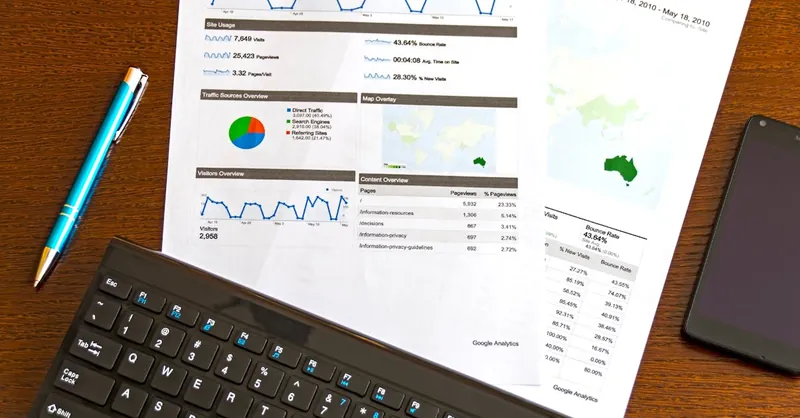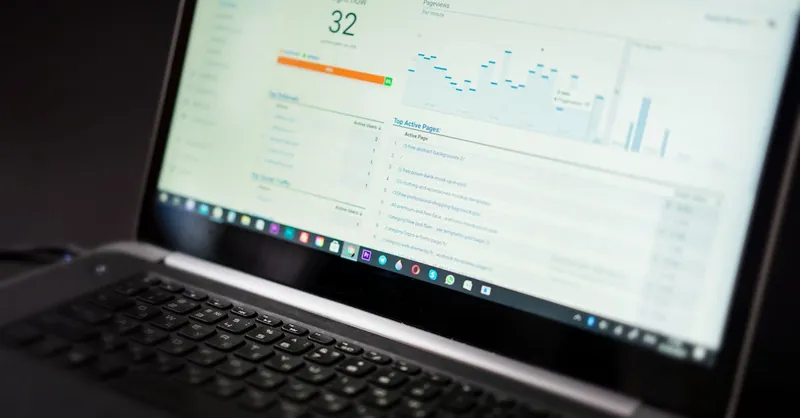Boost Productivity Through AI-Powered Analytics
Category: Productivity & Automation
Unlocking Efficiency: How AI-Powered Analytics Transforms Productivity
If you're a professional, entrepreneur, or tech enthusiast exploring ways to elevate your workflow, chances are you've encountered AI-powered analytics as a promising solution. Yet, pinpointing how exactly these tools can streamline your daily operations and decision-making often feels overwhelming. You want to move beyond buzzwords and understand practical applications that tangibly boost productivity, reduce guesswork, and save time.
This post is crafted precisely for readers like you—those with a solid grasp on technology and an eagerness to apply AI-driven insights to real-world productivity challenges. You'll discover a clear, structured approach to leveraging AI-powered analytics—not just as a tech trend, but as a strategic asset that enhances automation, uncovers hidden patterns, and guides smarter business choices.
We'll dive deep into the core benefits, best practices, tools, and integration strategies that make AI analytics indispensable. By focusing on actionable insights rather than theory, this post stands apart from generic overviews. Whether you manage projects, lead teams, or run a startup, reading on will arm you with a roadmap to transform data into productivity gains—helping you navigate your unique challenges and stay ahead in a fast-evolving digital landscape.
- Unlocking Efficiency: How AI-Powered Analytics Transforms Productivity
- Understanding AI-Powered Analytics: Definition, Core Technologies, and How It Differs from Traditional Analytics
- Key Benefits of AI Analytics for Productivity
- How AI Analytics Identifies Productivity Bottlenecks
- Integrating AI Analytics with Existing Tools: Best Practices for Seamless Adoption
- Real-World Use Cases: Measurable Productivity Improvements Driven by AI Analytics Across Industries
- Choosing the Right AI Analytics Tools: Criteria to Evaluate Software Based on Your Business Size, Data Complexity, and Goals
- Data Quality and Governance: Ensuring Reliable, Ethical Insights
- Measuring Impact: Key Performance Indicators to Track Productivity Gains and ROI from AI-Powered Analytics Deployment
- Future Trends in AI Analytics for Productivity: Explainable AI, Predictive Analytics, and Automation Synergy
- Overcoming Common Challenges: Addressing Barriers Like Data Silos, User Adoption Resistance, and Integration Complexity
Understanding AI-Powered Analytics: Definition, Core Technologies, and How It Differs from Traditional Analytics
AI-powered analytics refers to the use of advanced artificial intelligence technologies to automatically collect, process, and analyze large volumes of complex data, uncovering patterns and insights that drive more informed, efficient decision-making. Unlike traditional analytics, which often rely on manual data querying and static reports, AI-powered analytics leverages machine learning, natural language processing (NLP), and predictive algorithms to provide real-time, adaptive, and highly scalable intelligence tailored to specific business contexts.
At the heart of AI-powered analytics are several core technologies:
- Machine Learning (ML): Enables systems to learn from historical and streaming data to detect trends, anomalies, and predictive indicators without human intervention.
- Natural Language Processing (NLP): Allows users to interact with data through conversational queries, making analytics more accessible and intuitive.
- Automated Data Mining: Extracts useful knowledge from massive datasets faster and more accurately than traditional methods.
- Predictive and Prescriptive Analytics: Goes beyond describing past performance to forecasting future outcomes and recommending optimal actions.
This evolution from traditional rule-based analytics to AI-driven frameworks means that organizations can move from reactive, hindsight-driven analysis to proactive, foresight-enabled strategies. With AI-powered analytics, productivity boosts come from uncovering hidden efficiencies, automating routine data interpretations, and enabling faster, data-backed decisions that directly impact operational effectiveness. This shift accelerates workflows and reduces guesswork, making AI-powered analytics a transformative tool for today’s data-intensive, fast-paced work environments.

Image courtesy of Google DeepMind
Key Benefits of AI Analytics for Productivity
Harnessing AI-powered analytics delivers transformative advantages that directly enhance productivity across industries and roles. By uncovering insights faster, AI tools eliminate the time-consuming manual data crunching traditionally required, enabling professionals to zero in on critical trends and anomalies with unprecedented speed. This accelerated insight discovery reduces bottlenecks and empowers teams to respond promptly to evolving conditions, making workflows smoother and more agile.
Beyond rapid insight generation, AI analytics plays a pivotal role in enhancing decision-making. Through advanced predictive models and prescriptive recommendations, these systems transform raw data into actionable intelligence — guiding users toward smarter, evidence-based choices rather than guesswork. This leads to improved accuracy in forecasting, resource allocation, and risk management, all of which contribute directly to higher operational efficiency.
Perhaps most impactful on day-to-day productivity is AI’s ability to automate repetitive and mundane tasks. Routine activities like data cleansing, report generation, and performance monitoring can be handed off to AI systems, freeing up valuable human time for creative problem-solving and strategic initiatives. This automation not only accelerates task completion but also reduces errors, ensuring consistency and reliability in analytics outcomes.
In summary, the key productivity benefits of AI-powered analytics can be encapsulated as:
- Faster insight discovery, reducing time to value from data analysis.
- Improved, data-driven decision-making powered by predictive and prescriptive intelligence.
- Automation of repetitive workflows, enabling teams to focus on higher-impact activities.
These advantages collectively forge a powerful productivity multiplier, positioning AI analytics as an indispensable tool for professionals aiming to unlock new levels of efficiency and competitive advantage.

Image courtesy of AS Photography
How AI Analytics Identifies Productivity Bottlenecks
One of the most powerful applications of AI-powered analytics lies in its ability to detect and diagnose productivity bottlenecks by analyzing complex data patterns across workflows and operations. By continuously monitoring process metrics, resource utilization, and task sequences, AI algorithms can pinpoint where delays, redundancies, or inefficiencies occur—often revealing issues that remain hidden in traditional performance reviews or manual data inspection.
Leveraging Data Patterns to Uncover Inefficiencies
AI models excel at parsing vast amounts of structured and unstructured data, identifying subtle correlations and anomalies that indicate friction points in your workflow. For example:
- Time-series analysis helps spotlight stages in projects or operations where completion times consistently lag behind expectations.
- Process mining uncovers deviations from optimal task sequences, exposing unnecessary steps or handoff delays.
- Anomaly detection flags irregular performance dips or spikes, which can signal equipment malfunctions, human errors, or misallocated resources.
By highlighting these bottlenecks, AI analytics transforms raw operational data into targeted insights, enabling managers and teams to address root causes rather than symptoms. This clarity accelerates troubleshooting and aligns efforts toward high-impact productivity improvements.
From Detection to Actionable Insights
Beyond merely identifying problems, AI-powered analytics provides contextual recommendations based on historical data and predictive modeling. It can suggest:
- Workflow adjustments to eliminate redundant tasks.
- Optimal redeployment of resources to balance workloads.
- Automation opportunities for repetitive activities that slow down progress.
By turning complex data into clear, actionable intelligence, AI-powered analytics empowers organizations to streamline operations, reduce downtime, and unlock sustained productivity gains. This dynamic approach to identifying and resolving bottlenecks positions AI as a cornerstone for data-driven productivity enhancement in today's competitive landscape.

Image courtesy of Negative Space
Integrating AI Analytics with Existing Tools: Best Practices for Seamless Adoption
Successfully embedding AI-powered analytics into your current technology stack is vital for realizing its full productivity potential. Whether it’s project management software, CRM systems, or communication platforms, seamless integration allows AI insights to augment familiar workflows instead of disrupting them. To ensure smooth adoption, consider these best practices for coupling AI analytics with your existing tools:
-
Assess Compatibility and Data Flow
Begin by evaluating how well your project management, CRM, and communication platforms support external AI analytics integrations through APIs or native connectors. Prioritize tools that enable automated, bi-directional data flow to ensure analytics engines receive real-time inputs and can push actionable insights back into your workflows. -
Focus on User-Centric Design
Incorporate AI analytics within your existing platforms in ways that minimize friction for end users. Embedding custom dashboards, alerts, and recommendation widgets directly inside project boards or CRM timelines enhances accessibility and encourages consistent use without forcing employees to switch contexts. -
Leverage Automation for Data Preparation
Clean, structured data is foundational for accurate AI insights. Automate data cleansing, normalization, and enrichment within your systems to maintain high-quality inputs. This reduces errors downstream and boosts the reliability of productivity recommendations generated by AI. -
Implement Role-Based Access and Customization
Tailor AI insights and reporting to different team roles through configurable views and permissions. Project managers may require detailed progress forecasts, while sales teams might benefit more from customer behavior predictions. Customized experiences accelerate user adoption and maximize relevance. -
Prioritize Continuous Training and Feedback Loops
As AI models adapt to evolving data patterns and business needs, ongoing training and refinement are critical. Establish feedback channels where users can flag inaccurate predictions or request new analytics features, enabling iterative improvement and deeper integration value.
By following these best practices, organizations can seamlessly integrate AI-powered analytics with project management tools, CRM platforms, and communication systems, transforming vast data into actionable productivity enhancements without disrupting established workflows. This strategic alignment fosters widespread adoption, accelerates insights-to-action cycles, and ultimately drives sustained productivity gains enterprise-wide.

Image courtesy of Mikhail Nilov
Real-World Use Cases: Measurable Productivity Improvements Driven by AI Analytics Across Industries
AI-powered analytics is no longer a futuristic concept but a practical, high-impact solution driving measurable productivity gains across diverse sectors. By leveraging AI's ability to analyze massive datasets in real time, organizations unlock hidden efficiencies, reduce operational friction, and enable smarter decision-making—leading to quantifiable improvements in efficiency, output, and cost savings.
Manufacturing: Predictive Maintenance and Process Optimization
In manufacturing, AI analytics monitors equipment health through sensor data, predicting failures before they cause costly downtime. This predictive maintenance capability decreases unplanned stoppages by up to 30-50%, significantly boosting production line uptime. Additionally, AI-driven process mining identifies bottlenecks on assembly lines, enabling adjustments that optimize throughput and reduce cycle times. The combination of predictive insights and process optimization delivers substantial gains in operational productivity and asset utilization.
Retail and E-Commerce: Personalized Customer Insights and Inventory Management
Retailers harness AI analytics to analyze customer behavior patterns and forecast demand with high accuracy. These insights fuel personalized marketing campaigns that increase conversion rates and average order values. Simultaneously, AI-powered inventory management minimizes overstocks and stockouts by anticipating sales trends, reducing holding costs by up to 25%. Together, these analytics-driven strategies sharpen operational efficiency and accelerate revenue growth.
Healthcare: Streamlined Patient Care and Resource Allocation
In healthcare, AI analytics processes patient data to optimize scheduling, predict patient admissions, and recommend personalized treatment plans. This reduces wait times, enhances resource utilization, and improves clinical outcomes—all contributing to higher productivity among medical practitioners and operational staff. For example, some hospitals have reported a 20% reduction in patient length of stay after implementing AI-powered scheduling and care analytics.
Financial Services: Fraud Detection and Risk Management
Financial institutions deploy AI analytics to process transactional data in real time, rapidly identifying fraudulent activities with enhanced accuracy. This not only mitigates financial losses but also streamlines compliance workflows by automating reporting and risk assessment. Predictive analytics further support credit scoring and portfolio management, allowing teams to focus on high-value decision-making and improving overall efficiency.
Across these industries and beyond, AI-powered analytics transforms raw data into actionable intelligence that drives faster, smarter, and more efficient business processes. By adopting AI analytics, organizations achieve measurable productivity improvements while maintaining agility in increasingly competitive environments.

Image courtesy of Hyundai Motor Group
Choosing the Right AI Analytics Tools: Criteria to Evaluate Software Based on Your Business Size, Data Complexity, and Goals
Selecting the ideal AI-powered analytics tool is crucial to maximize productivity gains and ensure seamless integration with your unique business environment. Given the diverse landscape of AI analytics solutions, your choice should hinge on carefully evaluating how each platform aligns with your business size, data complexity, and strategic objectives. This tailored approach helps avoid costly mismatches and unlocks the full potential of AI-driven insights.
1. Business Size and Scalability
- Small to Medium-Sized Enterprises (SMEs): Look for AI analytics tools that offer user-friendly interfaces, easy deployment, and cost-effective subscription models. Cloud-based SaaS platforms with scalable pricing and minimal IT overhead are often ideal, enabling quick wins without extensive infrastructure investment.
- Large Enterprises: Prioritize solutions that handle high-volume, diverse data streams with advanced customization options and robust security features. These platforms should support enterprise-grade scalability, multi-department integrations, and sophisticated governance controls to meet complex organizational needs.
2. Data Complexity and Integration Capabilities
- Assess the type and volume of data your business generates—structured, unstructured, streaming, or batch. Choose AI analytics software capable of processing this data efficiently, using technologies like machine learning and NLP to extract meaningful insights.
- Ensure the tool supports seamless integration with your existing systems (CRMs, ERP, project management) via APIs and connectors. Automated data cleansing and enrichment features are critical to maintain data quality, which directly impacts the accuracy and reliability of AI-driven recommendations.
3. Alignment with Business Goals and Use Cases
- Define clear objectives such as boosting operational efficiency, enhancing customer insights, or automating reporting. Aligning your AI analytics tool selection with these goals ensures focused functionality rather than generic features.
- Evaluate whether the software offers predictive and prescriptive analytics capabilities tailored to your industry or specific productivity challenges. Tools with customizable dashboards, role-based access, and actionable alert systems enhance relevance and user adoption.
Quick Checklist for Evaluating AI Analytics Tools
| Criteria | Key Considerations |
|---|---|
| Business Size Compatibility | Scalability, cost structure, ease of use |
| Data Handling Capacity | Support for diverse data types and real-time processing |
| Integration Flexibility | APIs, connectors, automated data workflows |
| Analytical Depth | Predictive, prescriptive insights, customizable reports |
| Security and Compliance | Data privacy, access controls, regulatory adherence |
| User Experience | Intuitive UI, training resources, support |
By rigorously applying these criteria during your evaluation, you can confidently select an AI-powered analytics solution that not only complements your current technology ecosystem but actively drives productivity improvements tailored to your distinct operational landscape. This strategic alignment forms the foundation for sustained growth and competitive advantage in an increasingly data-driven world.

Image courtesy of Atlantic Ambience
Data Quality and Governance: Ensuring Reliable, Ethical Insights
For AI-powered analytics to truly boost productivity, maintaining high data quality and robust data governance is non-negotiable. Clean, accurate, and well-managed data forms the foundation for trustworthy AI insights that drive effective decision-making. Without rigorous data governance frameworks, organizations risk basing strategies on flawed, incomplete, or outdated information—undermining the value AI analytics promises.
The Pillars of Data Quality for AI Analytics
Ensuring data quality involves several critical practices:
- Data Cleansing: Regularly identifying and correcting errors such as duplicates, missing values, or inconsistencies to create a reliable dataset.
- Data Standardization: Applying uniform formats and definitions so data from disparate sources can be integrated seamlessly, enabling consistent AI analysis.
- Real-Time Data Validation: Implementing automated checks as data flows into AI systems to prevent garbage-in, garbage-out scenarios and maintain accuracy over time.
High-quality data empowers AI algorithms to generate precise, actionable insights that genuinely enhance productivity rather than introducing noise or bias.
Ethical and Compliant Data Governance
Alongside data quality, strong governance policies ensure data is collected, stored, and processed in a way that respects privacy, security, and regulatory compliance:
- Establishing clear data ownership and stewardship roles guarantees accountability for data integrity and lifecycle management.
- Enforcing access controls and encryption safeguards sensitive information from unauthorized use or breaches.
- Adhering to frameworks like GDPR, CCPA, or industry-specific regulations helps organizations mitigate legal risks while cultivating customer trust.
Integrating ethical considerations into AI analytics workflows not only protects your organization but strengthens the credibility of AI-driven productivity initiatives.
By meticulously managing data quality and governance, businesses unlock the full potential of AI analytics, ensuring insights are not only rapid and relevant but also reliable, ethical, and compliant—key factors that ultimately sustain productivity gains and long-term competitive advantage.

Image courtesy of Markus Winkler
Measuring Impact: Key Performance Indicators to Track Productivity Gains and ROI from AI-Powered Analytics Deployment
Effectively measuring the impact of AI-powered analytics on productivity is essential to validate investments and continuously optimize strategies. Tracking the right key performance indicators (KPIs) enables organizations to quantify productivity improvements, operational efficiencies, and the return on investment (ROI) derived from AI analytics adoption.
Core Productivity KPIs for AI Analytics Evaluation
-
Time Saved on Data Processing
Measure reductions in manual data preparation, analysis, and reporting times. A significant decrease in these durations signals accelerated insight discovery and freeing up human resources for higher-value tasks. -
Decision-Making Speed and Accuracy
Track improvements in how quickly decisions are made and the accuracy of outcomes compared to baseline metrics before AI integration. Faster, data-backed decisions reduce delays and increase confidence across teams. -
Operational Efficiency Gains
Monitor metrics such as throughput rates, cycle times, and resource utilization. AI-driven insights that identify and eliminate bottlenecks should translate into measurable performance boosts and leaner processes. -
Automation Impact
Quantify percentage reduction in repetitive task workloads through AI automation. This KPI highlights freed capacity for staff to focus on strategic initiatives and innovation. -
Cost Savings and Revenue Growth
Evaluate direct financial benefits such as decreased operational costs, reduced error rates, and increased sales or customer retention attributed to AI analytics insights. -
User Adoption and Engagement Rates
Track usage frequency of AI analytic tools and how embedded insights influence daily workflows. High adoption is often a leading indicator of sustained productivity gains.
Calculating ROI from AI-Powered Analytics
To comprehensively assess ROI, combine quantitative KPIs with qualitative feedback from users and stakeholders. Use this formula as a starting point:
ROI (%) = (Net Benefits from AI Analytics / Total Costs of Deployment) × 100
Where:
- Net Benefits include cost savings, productivity improvements, additional revenue, and intangible benefits like enhanced employee satisfaction or customer experience.
- Total Costs cover software acquisition, implementation, training, and ongoing maintenance.
By regularly monitoring these KPIs and ROI metrics, organizations gain transparent visibility into the value generated by AI-powered analytics initiatives. This disciplined measurement approach not only justifies continued investment but also drives iterative improvements—enabling businesses to strategically scale AI analytics efforts for maximum productivity impact.

Image courtesy of Negative Space
Future Trends in AI Analytics for Productivity: Explainable AI, Predictive Analytics, and Automation Synergy
As AI-powered analytics continues to evolve, emerging technologies are set to redefine how organizations boost productivity through even more transparent, proactive, and integrated intelligence systems. Understanding these future trends is key to staying ahead and fully leveraging AI’s potential in productivity enhancement.
Explainable AI (XAI): Enhancing Transparency and Trust
One of the most significant advancements on the horizon is explainable AI (XAI). Unlike traditional "black-box" AI models, XAI provides clear, interpretable explanations of how AI arrives at its insights and recommendations. This transparency addresses a critical productivity barrier—user trust and adoption—by enabling professionals to confidently understand and validate AI-driven decisions. With explainable AI, teams can not only act on analytics faster but also make more informed adjustments, reducing errors and friction caused by opaque algorithms.
Advanced Predictive Analytics: Anticipating Opportunities and Risks
While predictive analytics already plays a vital role in forecasting outcomes, future developments will introduce more granular and accurate predictions by integrating diverse data sources such as IoT signals, behavioral data, and real-time feedback loops. These improvements empower organizations to anticipate productivity bottlenecks, resource constraints, and market shifts well before they manifest. By harnessing advanced predictive models, businesses can shift from reactive problem-solving to proactive productivity management, dynamically optimizing workflows and resource allocation.
Automation Synergy: Combining AI Analytics with Intelligent Automation
The convergence of AI-powered analytics with intelligent automation technologies—including robotic process automation (RPA) and cognitive automation—is another transformative trend. This synergy enables end-to-end automation of decision-making and execution cycles, where AI analytics identifies patterns and prescribes actions, while automation technologies implement those actions instantly. Such integration not only accelerates operational throughput but also frees human talent to concentrate on strategic, creative work, driving exponential productivity growth across departments.
By embracing these future trends—explainable AI for transparency, enhanced predictive analytics for foresight, and automation synergy for seamless execution—organizations can unlock the next frontier of productivity gains. Staying informed and adaptive to these innovations ensures sustained competitive advantage in an increasingly AI-driven business landscape.

Image courtesy of Tara Winstead
Overcoming Common Challenges: Addressing Barriers Like Data Silos, User Adoption Resistance, and Integration Complexity
Despite the immense potential of AI-powered analytics to boost productivity, organizations often face significant obstacles that hinder successful implementation. Three of the most common challenges are data silos, user adoption resistance, and integration complexity—each requiring deliberate strategies to overcome for AI analytics to realize its full impact.
Breaking Down Data Silos for Unified Insights
Data silos occur when information is trapped within isolated departments, systems, or formats, preventing AI analytics platforms from accessing comprehensive datasets. These fragmented data landscapes reduce analytical accuracy and limit the actionable insights that AI can generate. Overcoming data silos involves:
- Implementing centralized data lakes or warehouses that aggregate diverse data sources into a unified, accessible repository.
- Establishing strong data integration protocols using APIs and ETL processes to enable seamless data flow across platforms.
- Promoting cross-functional collaboration that encourages data sharing and collective ownership of data assets, breaking down organizational boundaries.
By solving data silo challenges, businesses empower AI analytics with richer, more holistic datasets, unlocking deeper insights that translate into real productivity gains.
Navigating User Adoption Resistance through Inclusive Change Management
Resistance from employees and decision-makers often slows AI analytics adoption, especially when systems feel complex or threaten existing workflows. To foster widespread user buy-in and maximize AI’s productivity benefits:
- Engage users early in the selection and implementation process to align tools with their needs and reduce apprehension.
- Provide comprehensive training and ongoing support that demystifies AI capabilities and builds user confidence.
- Highlight clear, relatable examples of how AI analytics can simplify tasks and improve outcomes, reinforcing the value proposition.
- Promote a culture of experimentation and feedback where users feel empowered to influence system evolution.
Addressing adoption challenges ensures that AI analytics becomes an integrated part of daily workflows rather than an underutilized technology.
Simplifying Integration Complexity with Strategic Planning and Scalable Solutions
AI analytics must integrate smoothly with diverse existing tools to avoid operational disruption. However, complex legacy systems, incompatible data formats, and fragmented IT environments can pose hurdles. Best practices to mitigate integration complexity include:
- Conducting thorough assessments of current technology stacks and mapping data flows before AI analytics deployment.
- Opting for AI platforms with flexible, modular architectures and wide compatibility with popular enterprise applications.
- Using middleware and API management tools to facilitate secure, reliable data exchange while maintaining system performance.
- Investing in incremental integration roadmaps that prioritize high-impact areas first, minimizing risk and ensuring continuous productivity improvements.
By proactively addressing integration challenges, organizations can seamlessly embed AI analytics within their workflows, unlocking its productivity-enhancing potential without costly delays or technical bottlenecks.
Effectively overcoming these common barriers transforms AI-powered analytics from a promising concept into a practical, reliable productivity tool, driving measurable business outcomes in dynamic environments.

Image courtesy of Mikhail Nilov
